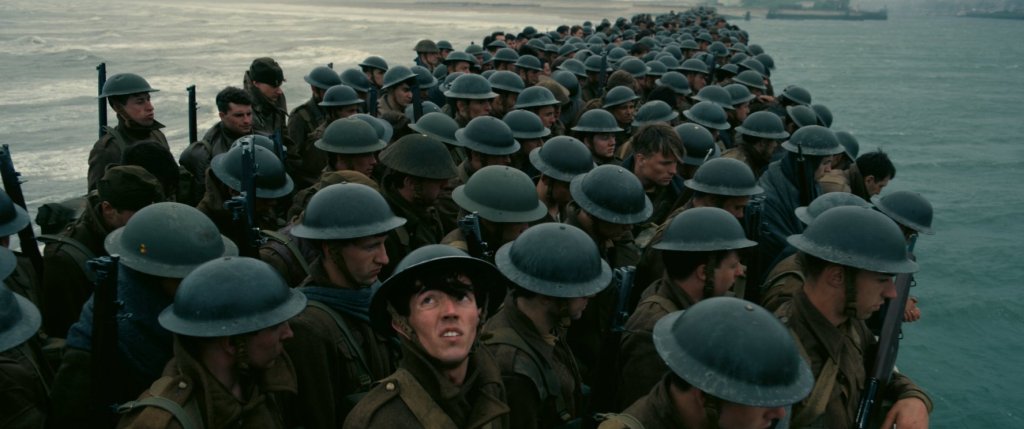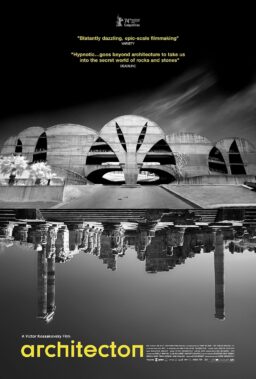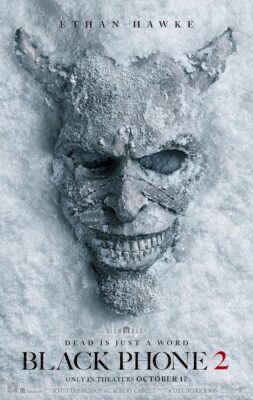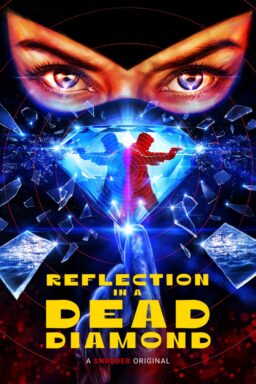We are pleased to offer an excerpt from the latest by online magazine Bright Wall/Dark Room, which now publishes content weekly but with a monthly theme. Their theme for October is “Action!”, and focuses on action/adventure movies from the past several decades. In addition to this essay by Amy Woolsey on Christopher Nolan’s “Dunkirk,” the issue also has new essays on “Predator,” “Speed,” “True Romance,” “Emperor of the North,” “Brazil,” “The Edge,” “Assassins,” “Spy,” “The Poseidon Adventure” and more. They’ve also launched a brand new version of their website.
One image from Dunkirk haunts me, creeping into my mind at random and shocking me out of everyday life, at least for a moment. Seeking refuge from the ongoing battle, soldiers huddle in a fishing trawler that has, like them, been stranded on the beach. Their refuge proves pitifully ephemeral. Before the men can get acquainted with one another, a blade of light pierces the shadows, accompanied by the sharp whistle of a bullet.
Down they go, flat against the rusty metal of the hull. Amid their panicked yells, more gunfire erupts, and more holes appear, forming a tight circle around the first. A realization dawns on one soldier: the shooters aren’t attacking; they’re practicing. They have no idea that there are people in the boat.
Morning slips away in this taut stillness, its passage marked only by the water that starts to pour through the bullet holes. It quickly becomes clear that the soldiers have no choice but to abandon ship. All of them manage to scramble out into the open, rescued by the tide—except one. Gibson, a Frenchman who stole the uniform and name of a slain Englishman, gets snared by a chain. The sea swallows him like quicksand. We last see him as a ghostly hand reaching out from the murky depths of his aquatic grave, as if clinging to the light.
I can’t let go of that hand.
*
When I heard that Christopher Nolan was going to follow up his sci-fi odyssey Interstellar with a movie about the Battle of Dunkirk, I felt the hard tug of disappointment. Compared to tesseracts and distant galaxies, war seemed mundane, conventional. Weren’t there enough tales of soldierly heroism and cruelty floating around the ether of cinema? What would this provide that Steven Spielberg hadn’t already? (For me, it is his HBO miniseries Band of Brothers, not Saving Private Ryan, that epitomizes the World War II narrative, with its tone of dignified sorrow.)
However, as Warner Bros. unveiled footage from Dunkirk, my resistance slowly crumbled. The trailers promised a different sort of war movie—one fueled by neither jingoistic pride nor macho cynicism, but rather by adrenaline. Absent were the usual platitudes about courage, honor, and sacrifice, the solemn orchestral score, and in their place was the foreboding tick of a clock. I had never thought that a movie comprised of a single, uninterrupted battle was something I craved, yet here I was, succumbing to excitement.
Of course, no trailer could fully prepare you for the experience of watching a movie like Dunkirk in a theater. Fragmented images don’t show the way the camera moves, sweeping across wide-open panoramas with avian grace or jostling in sync with the clumsy gait of a sprinting man. A snippet of music presented out of context can’t match the power of a full soundscape, layers of overlapping and mingling noises—cacophony blasted at maximum volume. Smartly, Nolan kicks his penchant for labored exposition, keeping dialogue to a minimum and discarding backstory; aside from the introductory text stating that Nazi Germany has invaded France, forcing Allied troops to await evacuation at the coastal city of Dunkirk, he offers no larger historical or political context. Instead, Dunkirk tells its story through action: things happen, and the characters respond. It immerses—imprisons—you in your senses, restricting the world to your immediate surroundings and gut instincts. Run. Hide. Live.
It’s pure spectacle.
The term “spectacle” tends to have a pejorative connotation. Nowadays, it conjures long fight sequences involving lots of explosions, crumbling buildings, and unseen casualties—the climax of Zack Snyder’s Man of Steel, to cite a notorious example. While such sequences may dazzle with flashy special effects and death-defying stunts, they leave the mind mushy and the heart cold. They’re the cinematic equivalent of fireworks, all sound and fury, signifying nothing. In his seminal work Society of the Spectacle, Marxist theorist Guy Debord argued that spectacle functions as a distraction, keeping the masses complacent and thereby preserving the status quo:
The spectacle is the nightmare of imprisoned modern society which ultimately expresses nothing more than its desire to sleep. The spectacle is the guardian of sleep.
Needless to say, Debord’s assessment is myopic, bearing little relation to the actual effect that movies have on viewers. Sitting in front of a screen doesn’t suddenly render people incapable of thought, as the entire field of film criticism can attest. And, maybe out of self-delusion, I have to believe that the feelings movies stir up—the laughter, tears, shocked gasps, and nostalgic sighs—matter; they aren’t merely opiates that wear off as soon as you leave the soothing dark of the theater. The giddy fatigue I felt after Dunkirk is different from the listless fatigue I felt after Man of Steel.
Critics have long debated the ethical implications of onscreen violence. How does it influence events in the real world? Are filmmakers obligated to portray violence and its consequences accurately? Can they? Or is depiction inherently glorification? On paper, Dunkirk is guilty of the same offense as most action blockbusters: it presents mass destruction as eye-candy. Although the violence isn’t overtly stylized or embellished with colorful CGI, neither is it especially brutal. It’s PG-13, after all; there’s no blood or spilled guts or mutilated bodies. The horror of seeing people turn to ash ultimately pales in comparison to the thrill of being inside the cockpit during an aerial brawl.
Yet, the cost of war can’t be measured in carnage alone. Cinema is strewn with memorable war films that contain sanitized violence (Paths of Glory, War Horse) or eschew violence altogether (The Best Years of Our Lives, 2017’s other Dunkirk-related release Their Finest). Like Kubrick, Spielberg, William Wyler, and Lone Scherfig, Nolan conveys devastation in other ways.
Namely, he focuses on the sheer scale of it. When Tommy, a private played by newcomer Fionn Whitehead, escapes from the besieged city to the beach, he finds soldiers standing there in lines, as if waiting to go through an airport security checkpoint. Silhouetted in the foreground, Tommy looks diminished. The soldiers number in the hundreds of thousands, but they could be infinite, a homogeneous swarm stretching farther than the eye can see. How can you fathom, let alone save, that many souls?
More than any other war film, Dunkirk reminded me of Titanic, James Cameron’s alternately beloved and derided 1997 epic romance. Both dramatize with harrowing clarity the failure of a machine—whether a passenger ship renowned for its grandeur or a military renowned for its discipline—and the ensuing mayhem. The lines of soldiers, so orderly, scatter at the whine of an approaching airplane. Hierarchies collapse, as authority figures are reduced to feeble bystanders. In an instant, an army transforms into a rabble, voices crying, “Don’t leave us!” in the night.
Even in death, the machine asserts its power, trapping people in its ruin. Literally, sometimes. A Royal Air Force pilot crashes into the sea, his Spitfire hit during a skirmish. He’s unscathed, but the plane’s canopy has gotten jammed and water is flooding the cockpit in a hurry. He slams his fist into the glass again and again, each time with palpably greater desperation, until, at last, a civilian sailor arrives and helps shatter it. The pilot narrowly misses being killed by his own aircraft.
Dunkirk itself operates like clockwork, divided into three separate perspectives that play out over three separate time frames: The “mole” section spans one week; the “sea,” one day; and the “air,” one hour. For the audience, this structure is initially disorienting, fragmenting the narrative into a series of jumbled snapshots, and eventually exhilarating, liberating us from the confines of linear existence; edits bend space and time like wormholes. For those inside the narrative, though, it’s stifling. They’re fixed in the here and now, progressing at a constant and inexorable pace along hidden trajectories toward the future. Similarly, the dissonance of Hans Zimmer’s score belies its claustrophobic precision. It’s a symphony of verbs: throbbing, quivering, churning, hammering, grinding, engulfing. The crescendos and synths and cyclic beats create a kind of rhythm, marking the anxiety that always courses beneath the ebb and flow of fear like a pulse, a sign of life but also imminent danger.
From time to time, you catch glimmers of humanity in the actors. Tom Hardy’s searching eyes, captivating even behind a mask. Mark Rylance’s slumped shoulders. Kenneth Branagh’s despairing grimace. As formidable as these men are, though, they aren’t the calm at the center of the storm so much as the barriers holding the storm back.
In a way, Nolan has spent his career pursuing an answer to the underlying question of Debord’s thesis: Can humans survive in a world of machines? All of his movies pit their heroes against an abstract entity, from the past (Memento) to evil (The Dark Knight trilogy) to reality (Inception), observing their struggles to retain some essence of themselves.
The director’s chronic obsession is, perhaps, natural; he grapples with a lower-stakes version of this dilemma on a regular basis. With Hollywood ceding increasingly more territory to brand-driven franchises, Nolan occupies a unique position, straddling the art house and mass-market realms. While other auteur-minded filmmakers find freedom on the indie circuit or turn to television, he continues to tell ambitious, idiosyncratic stories while working within the studio system and reaping blockbuster profits. It’s a dream scenario. Yet, his work reflects lingering tension between artist and industry, a deep ambivalence about his insider status and a rebellious impulse that success has not staunched.
During the Dunkirk press tour, Nolan caused a minor hullabaloo by denouncing Netflix for their distribution model, which bypasses the traditional theatrical release in favor of making movies instantly available at home. His comments struck some as elitist; as Compton-raised director Ava DuVernay pointed out, theaters aren’t accessible or affordable for everyone. It’s certainly true that Nolan owes a lot to the privilege of being a white man, and (like most prominent white male filmmakers) he seems oblivious to it. But I can’t help sympathizing with his stance. Maybe it’s because I grew up in foreign countries and only went to the theater when visiting relatives in the U.S. for summer break or Christmas; so limited, these trips were elevated in my mind to special occasions, events that you actively planned and anticipated. Regardless, for me, movies are inextricably linked to the theater, the magical moment when the lights dim and the white noise of chatter subsides to a hush.
Ultimately, I think Nolan’s mindset has less to do with a vague notion of cinematic purity than a yearning for the sublime—that exquisite, elusive mixture of terror and awe that inspired an entire movement of 19th century poets. Whether conscious or not, it’s evident in everything he does: his rigorous loyalty to film and practical effects; his willingness to embrace IMAX; his fondness for large-scale storytelling. Even when they’re as cumbersome as The Dark Knight Rises, his movies have the singular effect of making me fall in love with not only the individual film but also the medium as a whole, reminding me why I regard an ostensibly “fun” pastime with almost spiritual devotion. They feel fit to be played in a palace—imposing and visceral and, though crafted with obvious meticulousness, alive, blowing images up to mythic proportions. Aaron Stewart-Ahn put it best after observing the director on set: “For Nolan, I get the sense a movie is invested with such care that its reality is so vivid it might actually burn you.”
Here lies the difference between Man of Steel and Dunkirk. Whereas the former uses spectacle to make viewers feel big and powerful, the latter aims to make us feel small, vulnerable. It dares us to face our insignificance in the scheme of things, to view ourselves as if from a gliding airplane, high above the earth.
At any other time, I would have admired the movie for its technical ingenuity, the intricacy of its structure and stark beauty of its visuals. However, I doubt it would have resonated so strongly on an emotional level. Granted, these days, it’s possible to detect some relevant meaning in virtually every work of pop culture, from John Huston’s 1948 noir Key Largo to The CW’s time-traveling superhero show Legends of Tomorrow. Still, Dunkirk caught me off guard. Although it refrains from overtly engaging with ideology, it captures with unnerving (and, presumably, unintentional) accuracy the mood of 2017, the actual sensation of living during this time in history.
In Nolan’s hands, combat becomes an existential crisis. That we never see “the enemy’s” face is crucial; it transforms acts of war into acts of fate, malice delivered indiscriminately. Disasters pile up with nightmarish persistence: men scramble to get on a boat, only for a torpedo to sink it; a hostile plane gets shot down, but the wreckage ignites an inferno in the oil-drenched sea; a boy dies from falling down the stairs before he even reaches the battleground. All anyone can do is weather the blows, hope they land elsewhere. The various attempts at self-preservation seem not only futile, but absurd. You can’t shield yourself from a bomb. It doesn’t care if you’re lying down, standing, or doing jumping jacks; it kills you all the same. But ducking is preferable to doing nothing, accepting that you have no control.
Upholding a trend that began with The Prestige (2006), Dunkirk concludes with a montage. On the train home after the evacuation, Tommy reads out loud from a newspaper article. It’s the final passage of Winston Churchill’s now-famous June 4 speech to the House of Commons:
We shall go on to the end, we shall fight in France, we shall fight on the seas and oceans, we shall fight with growing confidence and growing strength in the air, we shall defend our island, whatever the cost may be, we shall fight on the beaches, we shall fight on the landing grounds, we shall fight in the fields and in the streets, we shall fight in the hills; we shall never surrender. And even if… this island, or a large part of it, were subjugated and starving, then our empire beyond the seas, armed and guarded by the British fleet, would carry on the struggle, until, in God’s good time, the new world, with all its power and might, steps forth to the rescue and the liberation of the old.
By itself, the speech sounds audacious, rousing. But to someone who has just endured a week of fighting, of defying death, it sounds like a dire warning: This will go on forever; you will never rest. The voiceover is accompanied by images of loss—helmets scattered on the beach, a burning plane—and interwoven with a variation on Edward Elgar’s “Nimrod,” a piece often used for memorial services in Britain. It’s a lament laced with irony. After a fleeting cut to black, the film offers one last shot of Tommy, his gaze utterly hollow as he lowers the newspaper. For only the second time, silence descends. The fight may be necessary. But mercy, it’s exhausting.











